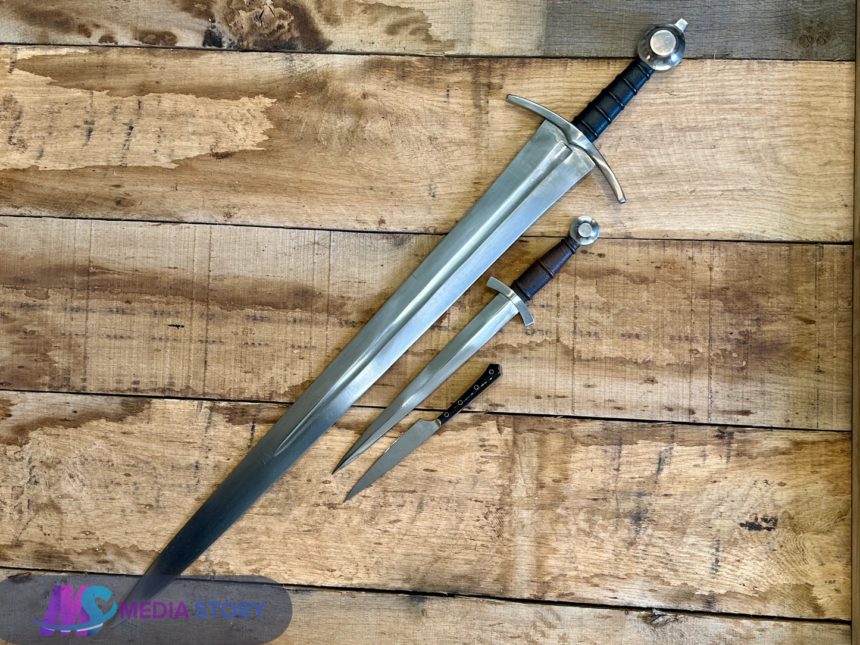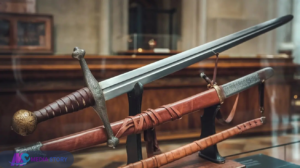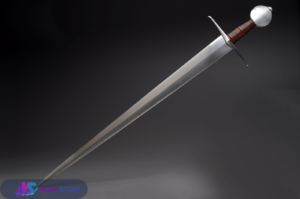The arming sword is one of the most iconic weapons from medieval history. Known for its versatility, balance, and effectiveness in battle, it was the primary weapon of knights and soldiers throughout the Middle Ages. The arming sword was lightweight yet powerful, making it ideal for both offense and defense. This article explores the history, design, combat use, and modern appreciation of this legendary weapon.
What is an Arming Sword?
The arming sword is a one-handed, double-edged sword that was commonly used from the 11th to the 16th century. Unlike the larger two-handed longswords, this weapon was typically paired with a shield or a buckler, giving knights flexibility in battle. It was often worn as a sidearm and used in single combat or during cavalry charges.
Key Features of an Arming Sword:
- Blade Length: 28 to 32 inches (approximately 70-80 cm)
- Weight: Around 2.5 to 3.5 pounds (1.1 to 1.6 kg)
- Blade Type: Straight, double-edged, and tapering to a point
- Grip: One-handed, with a simple crossguard for protection
- Pommel: Often rounded or disc-shaped to provide balance
Bio Table: The Arming Sword at a Glance
| Feature | Details |
| Type | One-handed medieval sword |
| Blade Length | 28-32 inches (70-80 cm) |
| Weight | 2.5-3.5 pounds (1.1-1.6 kg) |
| Era | 11th-16th century |
| Primary Use | Combat, self-defense, knightly warfare |
| Common Material | High-carbon steel |
| Modern Use | Collecting, reenactments, HEMA |
The History of the Arming Sword
The arming sword evolved from earlier Viking swords and became the standard weapon for European knights during the High Middle Ages. As armor improved, sword designs also changed, leading to more tapered blades capable of thrusting into chainmail and plate armor.
Early Development (11th-13th Century)
- Initially, arming swords had broad, flat blades designed for slashing.
- Used by Norman knights during the Battle of Hastings (1066).
- Common in Crusader warfare, often depicted in medieval manuscripts and effigies.
Later Evolution (14th-16th Century)
- Blades became narrower and more pointed to counter improved armor.
- More emphasis on thrusting attacks against weak points in plate armor.
- The arming sword gradually declined with the rise of longswords and rapiers.
How Was the Arming Sword Used in Combat?
The arming sword was a multipurpose weapon, effective in both cutting and thrusting. It was used in battles, duels, and self-defense. Here are some common techniques:
- Slashing Attacks: Wide swings to cut through lightly armored opponents.
- Thrusting Strikes: Precise stabs targeting gaps in chainmail and plate armor.
- Half-Swording: Gripping the blade with one hand for more control in close combat.
- Shield and Sword Technique: Used with a buckler or shield for defensive and offensive strategies.
Famous Warriors Who Used Arming Swords:
- Richard the Lionheart – Known for wielding an arming sword during the Crusades.
- Joan of Arc – A legendary female warrior often depicted with a sword of this type.
- Sir William Wallace – Scottish hero who likely used similar weapons in battle.
The Arming Sword in Modern Times
While no longer used in battle, the arming sword has a dedicated following among collectors, reenactors, and martial artists today. Historical European Martial Arts (HEMA) practitioners train with replicas to learn medieval combat techniques.
Where Can You Find an Arming Sword Today?
- Antique Collectors: Authentic medieval swords can be found in museums or private collections.
- Modern Replicas: High-quality reproductions are sold by companies like Albion Swords and Windlass Steelcrafts.
- HEMA and Reenactments: Many historical fighters use arming swords in mock battles and training.
How to Care for an Arming Sword
If you own a replica or antique arming sword, proper maintenance is essential:
- Keep it Dry: Moisture can cause rust, so store it in a dry place.
- Oil the Blade: Apply a light coat of oil to prevent oxidation.
- Sharpening: If it is a functional blade, keep it sharp with a whetstone.
- Safe Storage: Use a scabbard to protect the blade when not in use.
Arming Sword vs. Longsword: What’s the Difference?
| Feature | Arming Sword | Longsword |
|---|---|---|
| Grip | One-handed | Two-handed |
| Length | 28-32 inches | 36-48 inches |
| Use | Sidearm, single combat | Heavy combat, duels |
| Weight | 2.5-3.5 lbs | 3-5 lbs |
| Speed | Faster | More powerful |
Conclusion
The arming sword remains one of the most fascinating medieval weapons in history. From its practical design to its role in medieval warfare, it continues to captivate historians, collectors, and enthusiasts. Whether you’re a history buff, a HEMA practitioner, or a collector, the arming sword is a weapon worth appreciating.
FAQs
- What is an arming sword used for?
- It was primarily used in medieval combat for both slashing and thrusting.
- What is the difference between an arming swords and a longsword?
- The arming swords is one-handed, while the longsword is designed for two-handed use.
- How much does an arming swords weigh?
- Typically between 2.5 to 3.5 pounds (1.1 to 1.6 kg).
- Are arming swords still made today?
- Yes, many companies produce high-quality replicas for collectors and martial artists.
- What is the best material for an arming swords blade?
- Historically, they were made from high-carbon steel, and modern replicas often use similar materials.
- Can you use an arming swords in HEMA?
- Yes, many HEMA practitioners train with arming swords for historical combat practice.
- Did knights use arming swords in battle?
- Yes, knights often carried arming swords as their primary sidearm.
- How do you maintain an arming swordS?
- Regular oiling, sharpening, and safe storage help preserve the blade.
- What was the most famous battle involving arming swords?
- The Battle of Hastings (1066) is one of the most well-known battles where knights used arming swords.
- Where can I buy a high-quality arming sword?
- Reputable sellers like Albion Swords, Windlass Steelcrafts, and Cold Steel offer excellent replicas.









